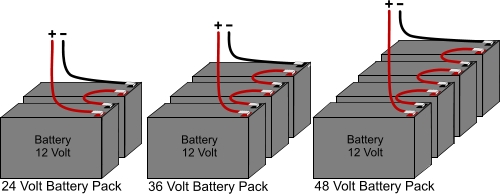How to Wire a Golf Cart with Three 12-Volt Batteries
Wiring Your Golf Cart Batteries for Optimal Performance - Need Help? Contact Us
Wiring your golf cart with three 12-volt batteries is an essential skill for any golf cart owner looking to enhance performance and extend battery life. Whether you’re upgrading your existing setup or starting fresh, understanding how to wire these batteries correctly will ensure your cart runs smoothly and efficiently. In this guide, we’ll walk you through the process step-by-step, providing tips and insights along the way.
Materials Needed for Wiring
Essential Components for Your Golf Cart Battery SetupBefore diving into the wiring process, it’s crucial to gather all necessary materials. Having everything on hand will make the installation smoother and more efficient. Here’s what you’ll need:
- Three 12-volt batteries: Opt for deep cycle batteries specifically designed for golf carts. These batteries are built to withstand repeated discharges and recharges, making them ideal for your needs.
- Battery cables: Choose heavy-duty cables that can handle the current without overheating. The gauge of the wire is important; typically, 4-gauge wire is recommended for golf cart applications.
- Wrenches and sockets: You’ll need these tools to securely fasten the connections at the battery terminals.
- Multimeter: This handy device will help you measure voltage and ensure that your wiring is correct before you hit the road.
Detailed List of Materials
| Item | Description |
|---|---|
| 12-Volt Batteries | Deep cycle batteries designed for golf carts, ensuring longevity and performance. |
| Battery Cables | Heavy-duty cables that can handle high current flow without overheating. |
| Wrenches/Sockets | Tools needed for securely tightening terminal connections. |
| Multimeter | A device to measure voltage, helping ensure proper setup before use. |
RAKOUR provides 12v series lithium batteries
Step-by-Step Wiring Instructions
Connecting Your Golf Cart Batteries in Series – For more battery setup tips, check out our guide on how to hook up golf cart batteries.Now that you have all your materials ready, it’s time to get started with the wiring process. Follow these steps carefully to ensure a successful installation:
- Position the Batteries: Start by placing the three 12-volt batteries securely in your golf cart’s battery compartment. Make sure they are stable and won’t move around during operation.
- Connect in Series: Begin by connecting the positive terminal of the first battery to the negative terminal of the second battery. This creates a series connection that is essential for achieving 36 volts.
- Continue Connecting: Next, connect the positive terminal of the second battery to the negative terminal of the third battery. At this point, you should have a series connection across all three batteries.
- Main Power Connections: Attach a main positive cable to the positive terminal of the first battery, which will serve as your primary power source. Then, connect a main negative cable to the negative terminal of the third battery.
- Secure All Connections: Double-check that all connections are tight and secure to prevent any power loss or potential short circuits.
- Test Voltage: Using your multimeter, measure the total voltage across your main terminals. You should see approximately 36 volts if everything is connected correctly
Calculation Formulas
To calculate total voltage from your batteries, use this simple formula:
Where V1, V2, and V3 represent the voltage of each individual battery.
Important Considerations When Wiring
Key Factors for Effective Golf Cart Battery Use – Learn how long you can expect your batteries to last by visiting our page on how long do golf cart batteries last.While wiring your golf cart is straightforward, there are several important considerations to keep in mind:
- Choose Deep Cycle Batteries: It’s vital to use deep cycle batteries rather than standard automotive batteries. Deep cycle batteries are designed for repeated discharges and can handle the demands of a golf cart without degrading quickly.
- Regular Maintenance: Regularly inspect your connections for corrosion or looseness. Clean any corrosion off terminals with a mixture of baking soda and water, and ensure that everything remains tight.
- Monitor Performance: Keep an eye on how well your golf cart performs after installation. If you notice any significant drops in speed or efficiency, it may be time to check your battery health or consider replacements.
recommended reading
Conclusion
Wiring a 36-volt golf cart using three 12-volt batteries is an achievable task that can significantly enhance your cart’s performance and reliability on the course. By following this comprehensive guide, you can ensure a secure and effective setup that maximizes efficiency while minimizing potential issues down the line. Always prioritize using suitable deep cycle batteries and maintain them regularly for optimal results.If you’re interested in learning more about battery maintenance or other related topics, feel free to explore our additional resources on how to charge golf cart batteries or how to test your golf cart battery. Happy golfing!
Learn How RAKOUR Can help you deploy
future-proof energy
Our team of energy storage experts will take the time to fully understand your business, challenges , and opportunities.

Li ion Battery vs. Lithium Phosphate: Key Differences
The debate between li-ion battery technology and lithium phosphate batteries is crucial for various applications,

Benefits of Switching to Lithium Batteries in Golf Carts
The 48V lithium golf cart battery offers significant advantages over traditional lead-acid batteries, including longer

How to build a golf cart battery with 18650 battery
Building a golf cart battery with 18650 lithium-ion cells is a detailed project that involves

Why LiFePO4 Lithium Battery Is Superior
LiFePO4 lithium batteries offer significant advantages over other lithium chemistries, including enhanced safety, longevity, and

What Makes LFP Batteries Unique?
Lithium Iron Phosphate (LFP) batteries offer unique benefits, including enhanced safety, longevity, and cost-effectiveness. This

Why is a 48V lithium battery more suitable for home battery backup systems?
The rising preference for 48V lithium batteries, especially LiFePO4 variants, in home battery backup systems
FAQs





